|
PART ONE
European traditions
Grecian mysteries and philosophy / Christianity
The 7th to 5th centuries B.C. are characterized by a remarkable
global birth of religio-philosophical ways of thought of astounding
profoundness:
-
Lao-tse and Kung-Fu-tse (Confucius) in China
-
Buddha
and Mahavira in India
-
Zarathustra in Persia
-
the prophets in
Palestine
-
the philosophers of Greece
An attempt was undertaken
by all these great sages to transcend the old myths and
superstitions of their time and present an in-depth approach. An
abstract, mystical way of seeing and experiencing reality was being
paved.
Some of these wisdom traditions became embodied in Greek culture.
Western European man learnt of their world of thought through
contacts with the Middle East and in particular Latin translations
of Greek philosophical works. The Greeks set them also on the trail
of Egyptian culture and religion. Knowledge about this great
civilization came to the Occident indirectly however in its Greek
version.
Actual contact with Egypt did not exist.
The Greeks, in their syncretistic turn of mind, absorbed in their
philosophy the essence of religious traditions that reached them
from other cultures through trade or wars. Egyptian initiation
rites, Thracian orphic mysteries and other ritual and cult practices
were amongst the many that were adopted readily.
God Hermes Trismegistus(=thrice great) was considered by them to be
identical with the ancient Egyptian God of wisdom Thoth. Modern
research has shown, however, that the Egyptian magical and mystical
works attributed to Hermes were written in the second and third
centuries A.D. These ideas became known as the Hermetic philosophy.
Its most important work is
the Corpus Hermeticum, a compilation of
fifteen texts on astrology, alchemy, theosophy and theurgy.
Back to
Contents
The Christian myth
Of the mystery school traditions Christianity had the most impact on
the West.
The originally pure Jewish sect would have gone into
oblivion after the Romans destroyed Jerusalem and most of its
inhabitants in 70 AD were it not that it had struck root in adapted
form in Jewish and Gentile communities in diaspora.
On the basis of the few documents that have survived from later
centuries scholars take it that a myth struck root around the Jewish
wisdom teacher Joshua (in Greek Jesus). The Christianity that became
of it had absorbed popular pagan religious beliefs. The qualities
attributed to Jesus are a reflection of those of the gods revered at
the time.
Godman Osiris-Dionysus for instance, was considered a Son
of God and was born to a virgin on the 25th of December before three
shepherds.
Back to
Contents
Gnosticism
Gnosticism originated in Egypt. The neo-platonic Gnostic school of
Alexandria became its centre in the first century A.D. From it
sprung Christian, Gentile and Jewish gnosticism. The latter survived
in the Jewish Kabbalah.
The various Gnostic sects played an important part in early
Christianity and the formation of the gospels. Their influence and
tradition were suppressed when the Jesus myth had struck root. Faith
became fused with the ruling power when emperor Constantine made
Christianity a state religion in the 4th century A.D. and placed
himself virtually at its head.
Gnosticism remained a source of inspiration, however, for the few
who knew of its ideas, which were kept secret. At the centre was the
belief that the seen and unseen world is the manifestation of the
One Divine Being. Gnostic texts concern the fall of man from the
divine to the material world. The spark of divine light imprisoned
in man is to be set free so that it may return to the Kingdom of
God. Gnosis, intuitive knowledge, is said to rank over analytical
knowledge. It was to be obtained by various initiations. Use of
hallucinogens may have played a part in obtaining mystical
experiences.
Gnosticism influenced many heretical West-European sects, such as
the Kathars in the Middle Ages, who were fiercely persecuted, and
mystics as Jacob Boehme (1575-1624).
In the eighth and ninth centuries A.D. Baghdad had become the great
intellectual centre of Arabic studies. Scientific and philosophical
books were disseminated through the Moorish emirate of Cordoba,
Spain.
The universities of Granada and Saragossa made translations
available of the great Greek classical works from Arabic into Latin.
Back to
Contents
Jewish mysticism and the Kabbalah
Another tradition that reached the Occident was that of Jewish
mysticism. Their esoteric doctrine the 'Kabbalah' (meaning:
tradition) appeared in Jewish mystic circles in Spain and Southern
France in the 12th century. Its oldest part, the Sefer Jetsira, was
written between the third and sixth century.
According to this belief God gave a second revelation to Moses
together with the Law. It explained the secret meaning of the Law.
This revelation is said to have been passed on down the ages by
initiates. Kabbalistic studies in the Hebrew scriptures developed in
a theosophical mystique and sometimes in a sort of unintended
religious magic.
Shortly before the expulsion of the Jews from Spain in 1492 Pico
della Mirandola in Florence conceived a Christian version of the
Kabbalah. He associated the Kabbalistic truths with those of Greek
Hermeticism.
Thus an amalgamy was introduced between the tradition
attributed to the Greek Hermes Trismegistus and Jewish mysticism
purportedly descending from Moses.
Back to
Contents
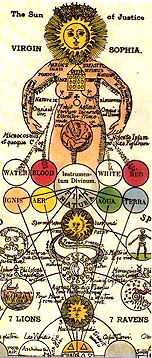 Alchemy Alchemy
The name 'alchemy' is derived from the Arabic el-kimya, Khem being
the name for Egypt where it was practiced even before the Christian
era. It blended with the magic and mysticism of the legendary Greek
Hermes Trismegistos which became known as the Hermetic philosophy.
In the fourth century A.D. alchemy evolved to its historical form.
Its tradition reached Europe through Muslim alchemists in Spain in
the twelfth century.
Mediaeval Alchemy contained Gnostic elements. In its popularized
form it is considered the art of mutation of metals. Yet, it went
deeper than that. It issued from the assumption that matter is alive
and may grow. With the right rituals matter could be influenced to
transmute into higher forms.
Under the cover of semi-scientific experiments its practitioners
followed a secret tradition. Thus, in its mystical sense alchemy was
not a search for the philosopher's stone, the transmutation of
metals into gold. Its deeper aspect was the search for purification
of the soul, the mystical transmutation of the mind necessary for
obtaining direct divine knowledge.
There were genuine and false alchemists in medieval times. Amongst
them were noblemen and common people, clergymen and laymen, Jews and
Christians, scientists and simple artisans, philosophers and
illiterates, doctors and magicians, in short from all classes of
society.
They wandered through Europe from one place to another.
They felt themselves cosmopolitans and as such held close
relationships with one another. They had their secret societies,
with signs and passwords. It was an oral tradition principally, from
ear to ear - mouth to mouth.
All that was written down was disguised
in order to give the impression that it concerned chemical
experiments only.
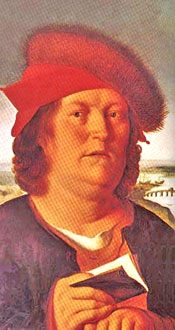
Paracelsus
In spite of their being persecuted more and more they kept
practicing their art secretly. Nevertheless their ideas had an
indirect influence on society.
One of the leading exponents of alchemy became the Swiss
Theophrastus Bombastus von Hohenheim, called Paracelsus (1493-1541).
Isaac Newton, at the risk of ending his life at the stake, conducted
the greater part of his life alchemical experiments.
Back to
Contents
The Renaissance
The Renaissance movement of the 15th and 16th centuries was born out
of a disenchantment with the Mediaeval philosophical and theological
way of thinking. A return to the source of knowledge of the distant
past was being advocated.
Although the Renaissance movement is usually known for its influence
on art and literature, in recent years it is realized that it was
also accompanied by a renewed interest in the study of old occult
Neoplatonic and Hermetic traditions.
Around 1450 a Platonic Academy was founded in Florence. In 1471 a
Latin translation of the recently rediscovered Greek Corpus
Hermeticum (see above) appeared.
The translation aroused renewed
interest in the Hermetic philosophy of the Greeks and went through
many editions
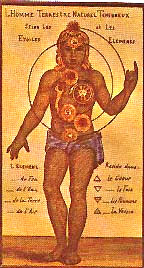
Illustration from "Theosophica Practica"
by 17th century mystic
Johann Georg Gichtel,
showing seven chakras
The magical mystery religion of ancient Egypt, being the oldest
civilization one had any knowledge of, exercised a great fascination
over the Renaissance men. The mysterious hieroglyphs were considered
to be symbols of hidden knowledge revealed by God to men that could
not be passed on in words. Symbols and gestures became means of
conveying truths and values.
The cosmos was seen as an organic
unity. It was peopled by a hierarchy of spirits which exercised all
kinds of influences and sympathies.
The practice of magic became a
holy quest, a search for knowledge, not through the intellect, but
by revelation to the pure in mind.
Back to
Contents
Freemasonry
The influence of the fresh interest in wisdom traditions in the wake
of the Italian Renaissance movement also found its expression in
Freemasonry, which became organized in lodges around 1600 in
Scotland.
Modern Freemasonry springs from the Medieval stonemasons who
wandered from one town to the other looking for assignments to build
a church, or even a cathedral, which required enormous skill,
intellectual and organizational talents. Guilds were set up in order
to guard the secrets of their craft.
The prestige of the architects, whose edifices were an object of
great admiration, was high. Being a member of the guild was
considered a privilege and had to be earned. Members recognized each
other not only by passwords, but also by their devotion and
philosophy which was laid down in the so called Old Charges. The
earliest version of this credo of the Freemasons, dates back to
1400. Later versions circulated in the 16th century.
The Old Charges embody the Hermetic quest for the lost wisdom of the
ancients. The Freemasons placed emphasis on morality and the study
of geometry.
Ancient Egyptian knowledge and the masters behind the great
architectural design of the lost Temple of biblical king Solomon
were in high esteem and a source of inspiration for the development
of masonic creativity. Master mason Hiram of this temple, murdered
because he would not reveal masonic secrets, was a source of
inspiration.
Masons felt also akin to the revered building guilds of ancient
Egypt, Greece, and Rome. The amazing architectural skill of the
ancient builders was attributed to supernatural powers. With great
devotion their treatises on geometry and mathematics were being
studied when they became available.
These craftsmen belonged to the "operative" side of Freemasonry.
Later members of the upper classes were admitted as well to Masonic
lodges. Their pursuit of occult and spiritual sciences, may have
been responsible for the development of a "speculative" side.
The aspiration of Freemasons for more freedom of thought, political
and religious reform, made it paramount that the activities were
conducted in utmost secrecy. Eventually the "operative" elements
would disappear.
In Scotland William Schaw (1550 - 1602) is considered to be the
brain behind the re-organization of the mason guild. In Great
Britain Elias Ahmole (1617-1692) was the forerunner.
In the diary of
this astrologer is a record of his initiation in 1646 into
Freemasonry, which already counted many members then, none of them
being stonemason by profession by that time.
Back to
Contents
The Rosicrucians
Associated with these traditions is the Rosicrucian movement which
appeared in the seventeenth century. They should not be mistaken for
the modern Rosicrucian groups, which have no direct connection with
the ancient movement.
At the basis of their emergence is the publication in 1614 of a
pamphlet, named
Fama (see image) (of the Fraternity of the
Meritorious Order of the Rosy Cross) addressed to the learned in
general and the governors of Europe.
Its author is
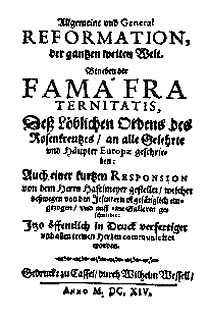 presumably
Johann Valentin Andraea (1586-1654), a young German Lutheran pastor. It
purported to be a message from certain adepts concerned for the
condition of mankind. In truth it is thought that its source was a
brotherhood of disappointed Lutherans who were not satisfied with
the results of hundred years of Reformation. presumably
Johann Valentin Andraea (1586-1654), a young German Lutheran pastor. It
purported to be a message from certain adepts concerned for the
condition of mankind. In truth it is thought that its source was a
brotherhood of disappointed Lutherans who were not satisfied with
the results of hundred years of Reformation.
In the Fama it was proposed that all learned men throughout the
world should join forces towards the establishment of a synthesis of
science. Behind this effort stood allegedly an illuminated
brotherhood - the children of light, who had been initiated in the
mysteries of the Grand Order.
This "Brüderschaft der Theosophen" was
said to be founded by
Christian Rosencreutz (1378-1484), who had
become an initiate during his travels in the Middle East in the
fifteenth century. He founded a brotherhood which was supposed to
have operated in secret ever since.
The pamphlets of the Order of the Rosy Cross were probably inspired
by Hermetic and NeoPlatonic scriptures which circulated at the time.
The Faerie Queene of Neoplatonist Edmund Spenser, and published in
1590 concerns an English knight 'Red Cross'.
The Rosicrucian
philosophy also contained elements found in freemasonry and
alchemistic writings such as the conception: "As above, so below" -
signifying that man mirrors the whole universe. Other ideas are
reminiscent of those of the great alchemist Paracelsus.
The Rosicrucian manifesto created quite a stir in European circles.
Although many applied for initiation there are no records of the
brotherhood having survived long. By 1623 the German Rosicrucian
movement was crushed under the weight of the Counter-Reformation led
by the Jesuits.
The occult Renaissance had come to an end. The tide
of witch-hunts had begun.
Back to
Contents
The Age of Enlightenment
The grip of fundamentalist Christianity weakened in the course of
the following decades.
The weltanschauung of European man was ever
broadening out. The world seas were being explored and contact made
with other cultures. The increasing population in an expanding and
more demanding society called for inventive skills. European
civilization struck root. Man of genius contributed to its culture.
Exploring nature with an intelligent mind became a coveted pursuit.
Anna Maria Schuurman (1607 - 1678) became the first woman to be
accepted as an academic.
A new kind of philosophy emerged, distinct from the Christian
world-view of medieval theologians.
The Age of Enlightenment can be said to have begun in 1687 by the
publication of Isaac Newton's; Philosophiae naturalis principia
mathematica (Mathemetical Principles of Natural philosophy). It was
the basis of exploring nature in an objective manner. The best minds
dedicated themselves to this critical pursuit: Galilei, Robert
Boyle, René Descartes, Francis Bacon.
Diderot began publishing installments of his famous
Encyclopédie in 1751. Alchemy was still
considered a scientific pursuit and is being described in the
encyclopedia in quite favorable terms.
The idea of freedom of thought emerged. Holland attracted many
persecuted Jewish, Huguenot and other refugees for its liberal
religious views. Spinoza in Amsterdam contributed to biblical
scholarship.
For the first time critical notes were placed behind
biblical texts. Stripping the Bible of its holy mystery had become
common place by the 18th century. Critical deism attacked and
downgraded conventional Christianity.
Voltaire, Rousseau, Thomas
Jefferson and Benjamin Franklin are rated among the deists.
The esoteric tradition had less to fear now.
Back to
Contents
Mesmerism and the French Revolution
Towards the end of the eighteenth century new scientific discoveries
and inventions had captured the public's mind. Specifically
experiments with electricity gave fuel to the most amazing and weird
theories involving fluïdum, ether or phlogiston to explain its
wonderful properties.
It is nowadays generally hushed up that the
great minds of that era, like Newton, believed in heretical notions
that would nowadays relegate a scientist to oblivion by the academic
community.
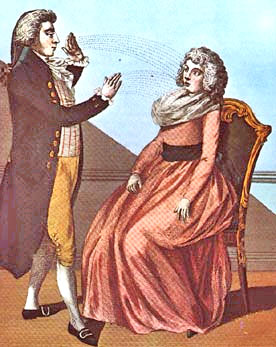
Mesmer hypnotizes somnabule
In the eighties of the 18th century an Austrian spirit healer, Franz
Anton Mesmer (1733-1815), exerted an enormous influence on the beau
monde as well the general public of France.
Ten years before the
outbreak of the French revolution his ideas captured the
imagination. He attributed his healing power to manipulating a fluïdum: animal magnetism. He worked with trance-induced states on
subjects called somnambules.
His occultism became generally accepted, except for the members of
the scientific community with whom he always was at war.
Other occult brotherhoods like Freemasonry, Rosicrucians, Kabbalists,
Swedenborgians and alchemists thrived, as did spiritualism. The
healing aspect receded in the background, communication with spirits
of the deceased, work with magical symbols and building a new vision
of reality came in its place.
This flight of ideas, its conflict with established order and
aristocracy became the breeding ground for the French Revolution.
Some of its leaders were once steeped in the world of mesmerism.
Back to
Contents
|
 Alchemy
Alchemy


